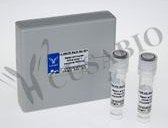Rabbit Anti Human FGFR1 PolyClonal AntibodyСпецификация| Объем | 100 мкл (100 мкг) | | Синонимы | FGFR1, BFGFR, CD331, CEK, FGFBR, FLG, FLJ99988, FLT2, HBGFR, KAL2, N-SAM, OGD, FGF Receptor 1 | | Клональность | Polyclonal Antibody | | Организм | Human | | uniprot | P11362 | | Иммуноген | Recombinant protein of human FGFR1 | | Источник | Rabbit | | Видовая специфичность | Human, Mouse, Rat | | Применение | ELISA, WB, IHC,WB:1:500-1:2000, IHC:1:50-1:200 | | Примечание | Fibroblast growth factors (FGFs) produce mitogenic and angiogenic effects in target cells by signaling through cell surface receptor tyrosine kinases. There are four members of the FGF receptor family: FGFR1 (flg), FGFR2 (bek, KGFR), FGFR3, and FGFR4. Each receptor contains an extracellular ligand binding domain, a transmembrane domain, and a cytoplasmic kinase domain. Following ligand binding and dimerization, the receptors are phosphorylated at specific tyrosine residues. Seven tyrosine residues in the cytoplasmic tail of FGFR1 can be phosphorylated: Tyr463, 583, 585, 653, 654, 730, and 766. Tyr653 and Tyr654 are important for catalytic activity of activated FGFR and are essential for signaling. The other phosphorylated tyrosine residues may provide docking sites for downstream signaling components such as Crk and PLCgamma. | | Клональность1 | Polyclonal | | Изотип | IgG | | Коньюгат | Non-conjugated | | Буффер | Buffer: PBS with 0.02% sodium azide, 50% glycerol, pH7.3. | | Форма | liquid | | Хранение | Upon receipt, store at -20°C or -80°C. Avoid repeated freeze. | | Метод очистки | Affinity purification | | Области исследований | Epigenetics and Nuclear Signaling,Neuroscience,Cancer,Cardiovascular,Signal transduction | | Ссылка на страницу на сайте производителя | ссылка | Western blot analysis of extracts of Jurkat cell lines, using FGFR1 antibody.
 | | | |
Информация для заказа| Область использования: | Производство: | Cusabio | | Метод: | | | Объем: | 100 мкл (100 мкг) | | Кат. номер: | CSB-PA008642KA01HU | | Цена (с НДС 20%): | по запросу | В корзину  |  Наименование: Rabbit Anti Human FGFR1 PolyClonal Antibody. Наименование: Rabbit Anti Human FGFR1 PolyClonal Antibody.
Примечание: дополнительная информация (на английском языке). |
|
